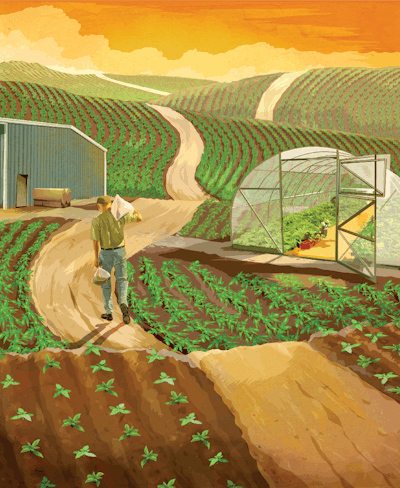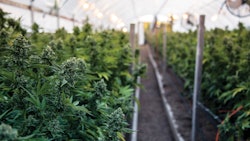

A year has passed since we wrote our first column for the January issue of Cannabis Business Times. Much has changed as normalization of the maturing cannabis industry unfolds and evolves. In our immediate futures, we will experience even faster and more profound changes. Successful entrepreneurs will be those who stay light on their feet and are able to make creative decisions as the legal and economic terrains shift. Here are five tips for navigating the regulated cannabis industry of the future.
1. Maintain clean nursery stock by starting from seed.
Consumers were once happy to buy virtually any cannabis they could find, but those times are long gone. Early growers sprouted seeds from imported shipments, grew plants in concealed gardens and harvested whichever ones matured. Each year’s crop was grown from different seeds, and no two plants were exactly alike. Few growers even considered taking cuttings until the 1980s.
Sowing seeds is still the initial step for many modern commercial cannabis cultivators, but these seeds are now grown into selected sinsemilla plants that may represent a farm, and potentially a popular brand. Once a plant has been selected, the usual approach is to root vegetative cuttings in order to perpetuate the proprietary cultivar indefinitely. Nurseries can offer these specially selected plants to other companies so they can grow fine flowers and define their own brands. In any scenario, the ability to access and maintain clean, healthy cuttings of important varieties becomes critical to establishing a satisfied customer base and a profitable company.
In our industry, the difficulty in maintaining clean mother plants of desirable cultivars has been compounded by the tandem necessity to scale up operations quickly. Growers also must remain in compliance with constantly shifting pesticide and fungicide regulations while providing consumers with whichever flavor-of-the-month they desire. This puts a great burden on plant breeders, nursery systems and growers. One result is the early release of plants into the market for cultivation that are agronomically challenging to propagate and may be contaminated by a host of pests and pathogens such as viruses, fungi, insects and mites. While scrambling to introduce new varieties, the cannabis industry spreads diseased plants that in turn infect the next cultivation facility, and so on down the line. In addition, as common insect pests such as whiteflies, thrips, fungus gnats and aphids infect a facility, they can quickly spread other pests and pathogens. Soon your chances of eradicating these problems become slim.
For years, cannabis growers have viewed these simply controlled pests as one of their primary agronomic challenges. Today, we take lessons from other agricultural crops and view these common pests as the vectors of far more damaging and difficult problems. Even relatively benign soil-borne critters such as springtails, whose presence is normally a sign of a functioning soil biome, can become vectors of pests and diseases, spreading them to healthy plants. Some fungal and viral pathogens may only require an open wound such as a broken leaf, or a stem cut for rooting, to find an entry point. Once living happily in mother plants, pathogens are spread far and wide through shared cuttings.
Sowing seeds offers growers the promise of a clean start. Vigorous pest-free plants, multiplied in a sterile facility and flowered in a clean environment, are three key elements of establishing an effective strategy for preventing catastrophic crop loss.
2. Choose a suitable growing environment.
Cannabis cultivation is largely about location. Once you have chosen the right variety to grow, it is imperative that you grow it under conditions most appropriate to that variety. Some varieties abhor heat, and others have little cold tolerance. Some are susceptible to local pests while others are resistant. As our cannabis industry matures, regions around the world will become known for environmental and economic conditions that favor profitable and successful cannabis farming. These “sweet spots” will become major production centers, and they will attract more, and bigger, businesses. Smaller companies established in less favorable and more challenging locations may find it difficult to compete.
By far, the most detrimental environmental factor is either a lack of or excess humidity. Outdoor grows across North America are subject to cooler and more humid autumn weather. Greenhouses easily warm a cold climate, but removing excess humidity can be challenging. Indoor grow rooms are often operated far too hot and dry. Outdoor and greenhouse growers should search for production sites in more arid regions where molds and mildews pose less of a natural threat. Indoor and greenhouse growers must be careful to maintain a beneficial balance between temperature and humidity. If these are not viable options, then cultivators should only grow varieties with inherited resistance to molds and mildews.
3. Avoid cannabis commodification.
As cannabis is increasingly produced by agribusiness, it will become increasingly commodified. Intense competition will bring down wholesale prices to as low as producers can tolerate. This is the way of agribusiness, but there will always appear opportunities for small-scale producers.
The more that cannabis is processed, the closer it comes to being a commodity. Isolates of CBD and THC are prime examples. The unique traits of cannabis varieties become less important when the targeted products are refined extracts or isolates rich in a single cannabinoid compound. Trading in these commodities is as simple as picking up the phone. Each step along the path—from buying flower biomass through whole flower extractions to isolating individual cannabinoids—results in relatively small profits.
Vertical integration (in states where it is permitted) is the best way to fight commoditization. It is certainly a lot simpler, cheaper and easier to supply flower and extract feedstocks to the industry via the commodities market than to invest the time, money and effort to develop a product line and promote a brand. However, the trade-off for ease of production and sales is a much lower profit margin. Companies that grow their own cannabis, and produce, package, distribute and sell their own products, create many more stages in the supply chain where they can profit.
For instance, whole flower extracts containing several cannabinoids, as well as a host of aromatic compounds (terpenes), present a wider range of potential effects than cannabinoid isolates, and they typically command a higher price. Producing, marketing and selling retail products made with these complex extracts will likely return much more profit than selling the same extracts to other companies that will sell them retail and glean much of the profit. There will remain a consistent high-end market for such sophisticated products, but their ultimate economic success will rely upon successful branding.
Normalization will certainly allow larger companies with huge marketing advantages to enter the cannabis sphere, and much of the market will soon be saturated with average-quality, mass-produced consumer products. This presents a great opportunity for smaller, specialized craft cannabis producers to fill the high-end connoisseur niches that should provide increased profits.
It is important to focus on a special product that you are comfortable producing, ideally from start to finish. Fresh start-ups must create, establish and promote their points of difference. What makes your brand stand out from the rest? Establishing a narrative describing the roots of your business and your personal vision is vital. Presenting unique cannabis varieties, natural production techniques, attractive packaging, boutique image, niche marketing and active promotion campaigns are becoming ever more important to running a profitable cannabis business.
4. Explore new directions in cultivar selection.
The search for new cannabis varieties is increasingly driven by selection of favorable agronomic traits such as ease of growing, high yields and enhanced pest resistance. No matter how wonderful a variety may be, it still must be produced economically to be profitable. Some popular varieties are quite difficult and therefore expensive to grow, and are often relatively low yielding as well. We will soon see more “grower’s varieties” that produce aromatic and potent flowers, but are also easier and more economical to grow—with lower water, fertilizer, pesticide and labor costs. Modern varieties are also being developed for targeted end uses such as dry flowers, sieved hashish or aromatic extracts.
Now that cannabis is becoming a global commodity, the opportunity to grow modern cultivars under ideal conditions, in appropriate regions worldwide, is greater than ever. As international cannabis business spreads into a range of environments, cannabis cultivars will be developed that perform well in these newly available environments and will become popular in regional markets. That said, these widely dispersed cultivars must prove themselves to the new wave of industrial-scale cultivators whose production standards will likely be more advanced from those of the old guard.
To provide customers with the confidence that the products they are consuming are and will remain consistent, and to protect the brands of licensed producers, the cannabis industry requires a varietal protection and certification system. This type of mechanism assures that the grapes used to make the wine consumers purchase are indeed Cabernet Sauvignon, and that the apples they are eating are really Honeycrisps. Currently in the U.S., cannabis companies may trademark the name on their packaging and patent the packaging itself, but they cannot trademark or patent the product inside.
There exists some cannabis patenting precedence, in that the U.S. Patent and Trademark Office granted a utility patent on cannabis plants expressing a designated cannabinoid and terpenoid profile, but whether that patent will be challenged in the courts, and how it will be dealt with commercially, remain uncertain. Crop plants are not required to be patented to enter the market, but companies’ abilities to trademark their products and attach their brands to particular varieties is a very important component of marketing agricultural crops.
When a specific cultivar expresses a unique chemical profile that satisfies certain medical conditions, then the requirement for access to this cultivar, grown under consistent conditions, becomes critical. (Editor’s note: See “Validating ‘Fire’: 10 Tips to Produce Consistent Perfection” on p. 56.) The need to provide consumers with the assurances they require calls for a more robust and informational naming system than simply allowing growers, distributors and budtenders to decide which flashy names should sell well this week.
5. Continue to promote cannabis legality and normalization.
We believe that soon, adult-use cannabis products will be legalized in the U.S. at the federal level. Momentum is clearly building toward that outcome. For the time being, American cannabis companies must continue to operate within a jigsaw puzzle of widely varying local and state legislation.
Simultaneously, nations around the world are softening their cannabis policies, and we should see export opportunities appear in the relatively near future. Each country will write its own rules determining what its citizens will be allowed to consume. International trading companies must become particularly sensitive to these developing regulations.
Much progress has already been made on the legalization and normalization fronts, and it is natural to focus on one’s own business and the local regulations. However, we have a long way to go before cannabis is universally legal and approved cannabis products become available in regulated marketplaces everywhere. We would not be benefiting from the positive opportunities we are offered today were it not for those who blazed the trail to normalization before us.
Prohibition has kept the price of cannabis high and thereby enriched a multitude of cannabis growers and dealers, while simultaneously financing drug warrior’s agendas. Many cannabis businesses operate today in an economic gray zone, in part supported by the lingering drug war mentality. Governments realized long ago that their wars on drugs are unwinnable; yet only recently have they begun to collect a wealth of fees and taxes they can redirect toward public issues, and most importantly to realize the powerful stimulus that cannabis businesses can provide to local economies. The drug wars will finally be reconciled, by governments and companies alike, through the spread of profitable cannabis business models. In order to understand how we came to our present position worldwide, and where we will go from here, just follow the money!

























